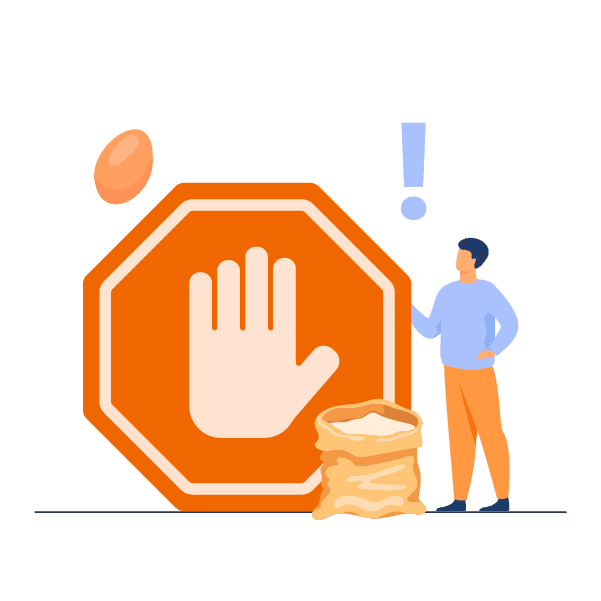The European Commission has banned titanium dioxide (E171) as a food additive in the European Union (EU) starting from 7 February 2022. There is a six-month transition period when foods containing titanium dioxide produced before 7 February 2022 may continue to be placed on the market until 7 August 2022, after which a full ban applies[1]. The ban follows an updated safety assessment by the European Food Safety Authority (EFSA) which concluded that titanium dioxide should be added to food additives & ingredients banned in Europe (see the list of the common ones below) and can no longer be considered safe as a food additive and that genotoxicity could not be ruled out[2].
In response to this ban, food companies that incorporated titanium dioxide in their products are now in a race to reformulate them to replace it with an alternative ingredient.
Safety is the number one priority for food manufacturers. Food companies should be well aware of the allowed and prohibited food ingredients and additives because violations can lead to serious issues including food recall, penalties and negative brand reputation.
In this article, we will discuss which common food ingredients and additives are banned in Europe, what it means for food businesses, and what you can do if you want to sell foods in the EU. This article is divided into the following sections:
- Which common food ingredients and additives are banned in the EU?
- How does the ban affect food companies?
- What should you do under the EU ban?
- Are you ready for the EU ban? Ask RegASK
Which food ingredients and additives are banned in the EU?
Let’s take a look at some examples of food ingredients and additives that are banned in the EU:
- Potassium bromate
- Azodicarbonamide
- Brominated vegetable oil (BVO)
- Olestra
- Titanium dioxide (TiO2)
- Sudan dyes
- Auramine O (AO)
- Rhodamine B
- Propylparaben
- Artificial colors (Yellow No. 5, No. 6, Red No. 40)
Only food additives that are listed in the EU legislation can be added to food and this can be done only under specific conditions. The additives that are authorized in foodstuffs and their conditions of use can be found in Annex II of Regulation (EC) No 1333/2008 on food additives[3]. There is also a food additive database available on the European Commission website for the public to search for permitted food additives[4].
Although these food additives are banned in the EU, some are still allowed in other countries such as the United States. BHA and BHT, for example, are approved by the U.S. Food and Drug Administration (FDA) as food additives[5].
Need to check any banned ingredients? Contact usHow does the ban affect food companies?
The EU ban was put in place after scientific research indicated that these items could potentially be harmful to human health. This means that a lot of artificial sweeteners, preservatives, and other additives will be off-limits for the food companies in order to ensure food safety. The regulations could have a significant impact on food companies, so it is important to be aware of what this means for you if you are running a business in the food industry. Here are some of the potential impacts:
- First, foods containing banned ingredients are not allowed to be sold. Companies trying to sell their
 products in Europe will encounter more barriers to market entry.
products in Europe will encounter more barriers to market entry. - Second, it will force food manufacturers to change what can be used as ingredients in food products, which opens opportunities for the emergence of new and healthier food choices.
- Third, there will be a disruption in food companies’ supply chain, as they may have to switch to suppliers who can provide alternative ingredients at the same price point and allow companies to retain the same food characteristics.
- The advertising strategies of food manufacturers and retailers may change along with the new buying behaviors of consumers.
In summary, the ban will have an immediate impact on food manufacturers’ capabilities to sell their products. Furthermore, it must be noted that these regulations are not just going to affect food manufacturing and buying behaviors; they are going to affect the entire business ecosystem, such as improving people’s nutrition and health, spurring innovations and new brands, shifting the market share of food companies, among other impacts.
What should you do under the EU ban?
If you are selling food in the EU, the questions you might be asking right now are: what should I do to protect my business from being disrupted by the banned ingredients? Are there ingredients potentially to be banned in the future and what is the best strategy to deal with such ban? How can I get early signals and anticipate risks to prepare for response to potential disruptions?
There is already a long list of potential changes food manufacturers may have to make if they want to keep selling their products in Europe. Here are recommended actions for food companies to ensure product safety while maintaining a competitive edge in light of the EU ban on food ingredients:
- If you wish to continue doing food business in the EU, you must comply with the regulation and ban. It’s essential to closely monitor and follow regulators’ requirements, and have a deep understanding and accurate interpretation of local regulations in order to avoid non-compliance. You can subscribe to the RegASK newsletter to receive free regulatory alerts.
- It’s important for your company to have a positive checklist of ingredients that you can use to ensure your products do not contain banned substances from start to finish.
- You will have to reformulate your products and find replacements or alternatives to the banned ingredients.
- Be transparent about your product’s ingredients by correctly labeling the food ingredients and communicating the right information. If needed, provide detailed information about the manufacturing process, and make positive and truthful product claims to give your consumers peace of mind when choosing a product.
- Comprehensively assess the impact of the ban on your business operations and supply chain, consider various scenarios and identify the best solution to survive and thrive under the ban.
- You may consider redesigning your product or regulatory strategy and expanding your product portfolio, for example exploring food categories that do not need the banned ingredients or their replacements and introducing the new products to your customers.
- The updated regulation also makes it difficult for businesses to predict the costs associated with the changes. In order to minimize the potential costly changes and maintain competitiveness in the market, food companies can also re-evaluate the target markets that they currently have and think about what new markets they can expand into. For example, you may consider shifting your focus from the EU market to Asian or American markets. Although the EU is a great market to sell in, it’s always recommended to find new areas of growth.
Are you ready for the EU ban? Ask RegASK
If you are running a food production business, you must be wondering how to implement the changes and where to start. With so many unknowns, food manufacturing companies will have to take a step back and make sure they are ready for this transformation before moving forward with any changes. It might be time to think about how you’re aligning your product marketing strategy with the company’s vision.
At RegASK, we specialize in designing regulatory, end-to-end product and market strategies to pave the way for your business to achieve commercial success. From regulatory monitoring, product development and regulatory submissions to go-to-market plans, we map out every step for you. For as long as your product is on the market, we ensure your compliance with local regulations through:
compliance with local regulations through:
- Dossier submissions
- Monitoring registration deadlines and renewal submissions
- Label and formulation compliance
- Compliance assessments for your products
If you want to redesign your business strategy and find the next area for commercial success, our team helps you achieve your goals by proposing forward-looking strategies for entering new markets and expanding product categories. Specifically, we can assist you to:
- Interpret local regulations and understand regulatory requirements
- Regularly re-evaluate your strategy
- Identify and eliminate the risk of category expansion
- Find new growth opportunities and markets with gap and match analysis
- Assess new markets and develop a path-to-market plan
In our case study, one of the world’s largest food companies planned to expand its product portfolio by introducing a new food product to 30 markets where they are present. Our assessment of regulatory risks and opportunities enabled the company to make informed decisions regarding the geographies they were targeting, read more.
Final Thoughts on Banned Ingredients in Europe
Food manufacturers must make sure that their products are safe for consumption by consumers. They can give consumers peace of mind by doing everything they can to protect consumers from harmful chemicals and banned ingredients that may be in the food. If you would like to find out more about the EU food regulations and bans and how they affect your business, schedule a free consultation with RegASK, our regulatory experts are happy to answer all the questions you may have.
References:
[1] U.S. Department of Agriculture – Titanium Dioxide Banned as a Food Additive in the EU
[2] European Food Safety Authority – Titanium dioxide: E171 no longer considered safe when used as a food additive
[3] International Food Additives Council – What are Food Ingredients?
[4] European Commission – Food Safety – Additives
[5] European Commission – Questions and Answers on Food Additives

